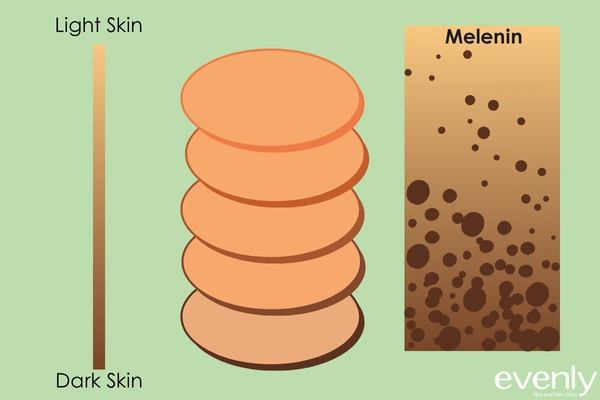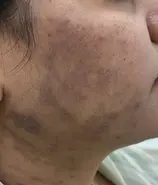Up to 25% OFF on Selected Treatments
-
Treatments
Acne and Scar
Pigmentation
Laser Hair Reduction
Dermato-surgery
Body
Anti Aging
Skin Rejuvenation
Others
- Clinics
- Blogs
Treatments
We all know that every individual is unique, whether it’s in their appearance, personality, characteristics, or attitude. One of the most noticeable differences among us is our skin color. From dark to light to tanned, you see a wide variety of skin tones everywhere you look. So, how do we end up with such different skin colors? Why do some of us have darker skin while others have lighter tones? Melanin is the natural pigment that determines the color of our skin, hair, and eyes. While melanin is essential for protecting our skin from UV damage, excessive melanin production can lead to hyperpigmentation, dark spots, and uneven skin tone. Let’s dive into the fascinating science behind our diverse skin colors and discover how to reduce, remove, and stop melanin production permanently, offering a clear understanding of what can and cannot be achieved.

Melanin, a complex polymer a raised from the enzymatic oxidation and polymerization of the amino acid L-tyrosine. It is produced by specialized cells called melanocytes, located in the basal layer of the epidermis. Melanin comes in two primary forms:
The type and amount of melanin produced by your body determine your skin, hair, and eye color. Melanin production is influenced by genetics, hormones, and sun exposure. When your skin is exposed to UV rays, melanocytes boost melanin production to create a protective shield. This is why you tan after spending time in the sun.
Melanin serves several crucial functions, including:
Here’s the key takeaway: Melanin is not your enemy. It’s your body’s natural defense mechanism against the damaging effects of the sun, which can lead to premature aging, wrinkles, and even skin cancer. Suppressing melanin production permanently could leave your skin vulnerable to these harmful rays.
Must Read: Freckles on Your Face: Causes, Treatments, and Prevention
Several factors can lead to excessive melanin production in your body. Here are the main contributors:
Completely stopping melanin production is a complex and largely unattainable goal due to the essential role melanin plays in protecting the skin from UV radiation. However, you can significantly reduce melanin production and maintain a lighter skin tone through various professional methods.
Permanently reducing melanin in your skin might be challenging, but with the right treatment and consistent care, you can achieve and maintain a lighter, more even skin tone. One of the most effective methods to help manage and minimize melanin production is laser treatment. But remember, before undergoing any laser treatment, it is essential to consult a board-certified dermatologist to thoroughly understand the procedure and its implications.
Must Read: How to remove Black Spots on the face effectively?

One of the best ways to reduce melanin permanently is through laser treatment. At Evenly Clinic, our dermatologists use USFDA-approved Tribeam Q-switched YAG laser equipment to target melanin pigment in the skin.
Number of Sessions
The number of Q-switched YAG laser treatment sessions required varies depending on several factors:
On average, most patients require multiple sessions spaced a few weeks apart to achieve optimal results. Our dermatologist will provide a personalized treatment plan based on your skin type and pigmentation levels.
Must Read: Effective Tan Removal Treatments to Restore Your Natural Glow.
Chemical peels involve applying a chemical solution like glycolic acid or trichloroacetic acid to the skin, causing it to exfoliate and remove dead skin cells, reducing pigmentation. These treatments can provide significant improvement in hyperpigmentation but require proper post-treatment care and sun protection.
Every person desires their skin to be perfect without any pigmentation. If you want to reduce or remove melanin from your skin and achieve a lighter complexion, there are several effective ingredients. While you can’t completely stop melanin production due to its protective role, you can reduce its appearance safely and effectively. Here are certain skincare ingredients that help manage melanin production and reduce it over time. These include:
These ingredients can be effective in reducing melanin production and lightening the skin, but their effects are not permanent and require regular use.
Witness the transformative results of melanin treatment through our before and after photos. Our patients experience remarkable improvements in skin tone and texture, showcasing the effectiveness of our advanced treatments.


Myth: Sunscreen is only necessary on sunny days.
Fact: UV rays can penetrate clouds and windows, necessitating daily sunscreen use.
Myth: Lemon juice effectively lightens skin.
Fact: Lemon juice can irritate the skin and increase sensitivity to sunlight.
Myth: Melanin production decreases with age, leading to lighter skin.
Fact: Aging affects melanin distribution but does not necessarily decrease its production in the skin.
Myth: People with darker skin produce more melanin than those with lighter skin.
Fact: Melanin production varies among individuals of all skin tones based on genetic predisposition and environmental factors
Stopping melanin production permanently is a myth. However, there are effective ways to manage and reduce melanin production to achieve a lighter, more even skin tone. It’s essential to set realistic expectations and understand that most treatments require ongoing maintenance and sun protection to sustain results. Consulting with a dermatologist can help you choose the most appropriate treatments and skincare regimen for your skin type and concerns.
At Evenly Clinics, we are dedicated to helping you achieve your skincare goals with safe, effective, and scientifically-backed treatments. Get in touch today to book your consultation and take the initial step towards a brighter, more even complexion.
For health-related information, follow us on Instagram.
Click here for an online consultation.
What is melanin, and why is it important for skin?
Melanin is a natural pigment produced by melanocytes in the skin. It plays a crucial role in protecting the skin from UV radiation by absorbing and dissipating harmful rays there, reducing the risk of sun damage and skin cancer.
Can melanin production be stopped permanently?
No, natural melanin production cannot be stopped permanently. It is influenced by genetic factors, UV exposure, hormonal changes, and other environmental factors. While treatments can reduce melanin temporarily, they cannot eliminate it.
How does UV radiation affect melanin production?
UV radiation from the sun stimulates melanocytes to produce more melanin as a defense mechanism against sun damage. Prolonged exposure to UV rays can lead to increased melanin production, resulting in tanning or hyperpigmentation.
What should I do if I notice changes in my skin’s pigmentation?
If you notice sudden changes in your skin’s pigmentation, such as dark spots or patches, it’s essential to consult with a dermatologist. They can evaluate your skin, diagnose any underlying conditions, and recommend appropriate treatments to manage melanin levels and restore skin health.
Can hormonal changes affect melanin production?
Yes, hormonal changes, such as during pregnancy or due to medications, can increase melanin production. This may lead to conditions like melasma, characterized by dark patches on the skin. Managing hormonal fluctuations and using sun protection is essential in preventing and managing these pigmentary concerns.
We hope this information is helpful. If you have any skin and hair-related questions or would like to discuss personalized solutions, please reach out to us at 7337899030. Our team of specialists is committed to delivering personalized care tailored to your specific needs. Take the first step towards a healthier, more confident you by scheduling a consultation with us today. Your journey to vibrant skin and stronger hair begins here.
Book an Appointment
Start your journey to healthy skin and hair today.
Leave a Comment